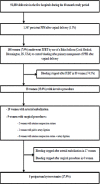Predictors of failed intrauterine balloon tamponade for persistent postpartum hemorrhage after vaginal delivery
- PMID: 30365539
- PMCID: PMC6203390
- DOI: 10.1371/journal.pone.0206663
Predictors of failed intrauterine balloon tamponade for persistent postpartum hemorrhage after vaginal delivery
Abstract
Objective: To identify the predictors of intrauterine balloon tamponade (IUBT) failure for persistent postpartum hemorrhage (PPH) after vaginal delivery.
Design: Retrospective case-series in five maternity units in a perinatal network.
Setting: All women who underwent IUBT for persistent PPH after vaginal delivery from January 2011 to December 2015 in these hospitals.
Methods: All maternity apply the same management policy for PPH. IUBT, using a Bakri balloon, was used as a second line therapy for persistent PPH after failure of bimanual uterine massage and uterotonics to stop bleeding after vaginal delivery. Women who required another second line therapy (embolization or surgical procedures) to stop bleeding after IUBT were defined as cases, and women whom IUBT stopped bleeding were defined as control group. We determined independent predictors for failed IUBT using multiple regression and adjusting for demographics with adjusted odds ratios (aORs) and 95% confidence intervals (95% CI).
Results: During the study period, there were 91,880 deliveries in the five hospitals and IUBT was used in 108 women to control bleeding. The success rate was 74.1% (80/108). In 28 women, invasive procedures were required (19 embolization and 9 surgical procedures with 5 peripartum hysterectomies). Women with failed IUBT were more often obese (25.9% vs. 8.1%; p = 0.03), duration of labor was shorter (363.9 min vs. 549.7min; p = 0.04), and major PPH (≥1,500 mL) before IUBT was more frequent (64% vs. 40%; p = 0.04). Obesity was a predictive factor of failed IUBT (aOR 4.40, 95% CI 1.06-18.31). Major PPH before IUBT seemed to be another predictor of failure (aOR 1.001, 95% CI 1.000-1.002), but our result did not reach statistical significativity.
Conclusion: Intrauterine balloon tamponade is an effective second line therapy for persistent primary PPH after vaginal delivery. Pre-pregnancy obesity is a risk factor of IUBT failure.
Conflict of interest statement
The authors have declared that no competing interests exist.
Similar articles
-
Intrauterine balloon tamponade for management of severe postpartum haemorrhage in a perinatal network: a prospective cohort study.BJOG. 2017 Jul;124(8):1255-1262. doi: 10.1111/1471-0528.14382. Epub 2016 Oct 25. BJOG. 2017. PMID: 27781401
-
Prognostic factors for the use of intrauterine balloon tamponade in the management of severe postpartum hemorrhage.Int J Gynaecol Obstet. 2018 Jul;142(1):48-53. doi: 10.1002/ijgo.12498. Epub 2018 Apr 17. Int J Gynaecol Obstet. 2018. PMID: 29603742
-
[Can we predict intrauterine balloon tamponade failure according to the mode of delivery?].Gynecol Obstet Fertil Senol. 2024 Sep;52(9):511-516. doi: 10.1016/j.gofs.2024.03.013. Epub 2024 Mar 29. Gynecol Obstet Fertil Senol. 2024. PMID: 38556133 French.
-
Intrauterine balloon tamponade in the management of severe postpartum haemorrhage after vaginal delivery: Is the failure early predictable?Eur J Obstet Gynecol Reprod Biol. 2021 Mar;258:317-323. doi: 10.1016/j.ejogrb.2021.01.030. Epub 2021 Jan 20. Eur J Obstet Gynecol Reprod Biol. 2021. PMID: 33498006 Review.
-
Uterine balloon tamponade for the treatment of postpartum hemorrhage: a systematic review and meta-analysis.Am J Obstet Gynecol. 2020 Apr;222(4):293.e1-293.e52. doi: 10.1016/j.ajog.2019.11.1287. Epub 2020 Jan 6. Am J Obstet Gynecol. 2020. PMID: 31917139
Cited by
-
Intrauterine Vacuum-Induced Hemorrhage-Control Device for Rapid Treatment of Postpartum Hemorrhage.Obstet Gynecol. 2020 Nov;136(5):882-891. doi: 10.1097/AOG.0000000000004138. Obstet Gynecol. 2020. PMID: 32909970 Free PMC article. Clinical Trial.
-
Predictors of Failed Intrauterine Balloon Tamponade in the Management of Severe Postpartum Hemorrhage.Front Med (Lausanne). 2021 Jul 15;8:656422. doi: 10.3389/fmed.2021.656422. eCollection 2021. Front Med (Lausanne). 2021. PMID: 34336876 Free PMC article.
-
Conservative Surgical Management of Early Postpartum Hemorrhage: A 12-Year Experience in a Tertiary Care Center in the South of Thailand.J Obstet Gynaecol India. 2022 Aug;72(Suppl 1):180-185. doi: 10.1007/s13224-022-01628-9. Epub 2022 Feb 23. J Obstet Gynaecol India. 2022. PMID: 35928068 Free PMC article.
-
Chitosan-covered tamponade for the treatment of postpartum hemorrhage: a registry-based cohort study assessing outcomes and risk factors for treatment failure.BMC Pregnancy Childbirth. 2025 Feb 5;25(1):120. doi: 10.1186/s12884-025-07236-5. BMC Pregnancy Childbirth. 2025. PMID: 39910452 Free PMC article.
-
Factors Associated with Failure of Bakri Balloon Tamponade for the Management of Postpartum Haemorrhage. Case Series Study and Systematic Review.Healthcare (Basel). 2021 Mar 8;9(3):295. doi: 10.3390/healthcare9030295. Healthcare (Basel). 2021. PMID: 33800388 Free PMC article.
References
-
- Sentilhes L, Vayssière C, Deneux-Tharaux C, Aya AG, Bayoumeu F, Bonnet MP, et al. Postpartum hemorrhage: guidelines for clinical practice from the French College of Gynaecologists and Obstetricians (CNGOF): in collaboration with the French Society of Anesthesiology and Intensive Care (SFAR). Eur J Obstet Gynecol Reprod Biol. 2016;198:12–21. 10.1016/j.ejogrb.2015.12.012 - DOI - PubMed
MeSH terms
LinkOut - more resources
Full Text Sources


